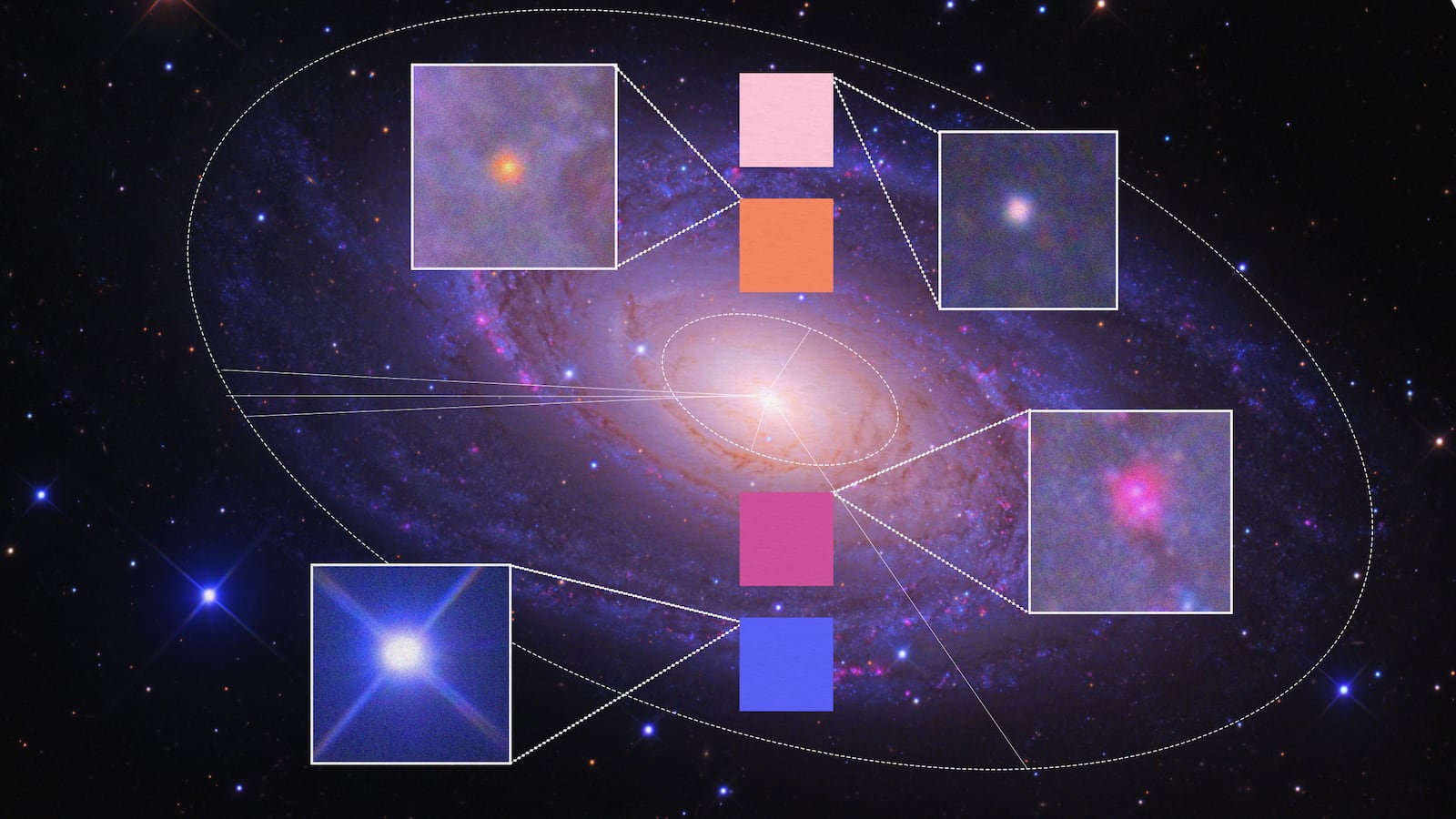There’s a theory that’s in vogue in astrochemistry called “Assembly Theory.” It posits that highly complex molecules—many acids, for example—could only come from living beings. The molecules are either part of living beings, or they’re things that intelligent living beings manufacture.
If Assembly Theory holds up, we could use it to search for aliens—by scanning distant planets and moons for complex molecules that should be evidence of living beings. That’s the latest idea from Assembly Theory’s originator, University of Glasgow chemist Leroy Cronin. “This is a radical new approach,” Cronin told The Daily Beast.
But not every expert agrees it would work—at least not anytime soon. To take chemical readings of faraway planets, scientists rely on spectroscopy. This is the process of interpreting a planet’s color palette to assess the possible mix of molecules in its atmosphere, land, and oceans.
Spectroscopy isn’t an exact science. That could leave alien-hunting astrochemists and astrobiologists guessing, for now. “There are a lot of uncertainties,” Dirk Schulze-Makuch, an astronomer at Technical University Berlin, told The Daily Beast.
Scientists have been actively searching for signs of alien life for at least a century. The search for extraterrestrial intelligence (SETI) accelerated in the 1950s and ’60s, with the advent of radio-based SETI. In radio SETI, scientists point sensitive radio receivers into the sky and listen for faint signals that might have originated with some alien civilization.
In the decades after radio SETI caught on, astronomers expanded their search. Increasingly powerful telescopes allowed them to capture colorful spectroscopic images of planets and moons, and then interpret those colors to make educated guesses at the chemical composition of the atmosphere. Certain elements could be prerequisites for life. Many astrobiologists agree that a planet should have carbon, hydrogen, nitrogen, oxygen, sulfur, and phosphorus just to have a chance of supporting biological evolution.
Once life has evolved on some faraway exo-planet, it might paint the planet in complex molecules mixing these and other elements. There could be chlorophyll, the substance that allows plants to absorb energy from light. It’s made up of a family of molecules combining carbon, hydrogen, oxygen, and magnesium that, altogether, gives it a molecular mass of nearly 900.
But chlorophyll isn’t the only complex molecule that could be a marker of life. According to a new peer-reviewed study from Cronin and his British and Spanish colleagues, most molecules with a molecular mass of at least 300 could be evidence of extraterrestrial microbes, or even intelligent aliens.
Cronin and his team arrived at this conclusion after analyzing 10,000 chemicals that are present here on Earth. “Most molecules greater than [a] molecular weight [or mass] of 300 [are] connected to the existence of life on Earth,” they wrote.
These complex molecules make up our bodies, our bodies’ waste products, and even the chemicals we manufacture. Pharmaceuticals, for instance. “This is because complex molecules… are too complex to form by chance in any detectable abundance, and therefore can only be made by the complex biochemical pathways found in biological cells,” Cronin and his co-authors wrote.
In other words, if you find complex molecules on some distant planet or moon, then you’ve probably found life, Cronin and company asserted.
That’s an exciting prospect for scientists, but there’s a hitch: Not everyone agrees what “complex” means. Yes, a molecular mass of at least 300 roughly correlates with Cronin’s notion of complexity. But there are too many possible exceptions, including forms of chlorophyll, for mass alone to be the standard. “There are many competing notions of chemical complexity,” Cronin and his team conceded.
Cronin’s Assembly Theory addresses this problem. The theory “estimates the complexity of a molecule by quantifying the minimum constraints required to construct an object from the building blocks.” In plain English, the theory asks how many times, at a minimum, a simple molecule would need to add an element or copy part of itself in order to achieve a given structure.
Any molecule that needs 15 steps should achieve a molecular mass of 300 or greater and qualify as “complex,” according to Cronin. And if Earth chemicals are any guide, the widespread presence of such a complex molecule on an alien planet or moon is a strong sign of nearby living things.
Niels Ligterink, a physicist at the University of Bern in Switzerland, told The Daily Beast he agrees with Cronin’s thinking. “In general, I would say that chemical complexity, in this case determined with Assembly Theory, is a good additional tool to search for life.”
Assembly Theory helps to sidestep a big question in astrobiology, Ligterink added. Life on Earth has DNA or RNA, the nucleic acids that carry genes. It’s not safe to assume alien life would share this basic structure, Ligterink said. “But we can be fairly certain that extraterrestrial life is also chemically complex.”
But applying Cronin’s theory to the day-to-day search for alien life is easier said than done. How can a scientist sample molecules on an “exoplanet” that’s light-years away? They simply cannot—not with today’s technology, anyway. The best they can do is survey an exoplanet with a powerful telescope—the new James Webb Space Telescope or the Vera Rubin telescope in Chile, to name two—and analyze the color palette through spectroscopy.
See, every element absorbs certain wavelengths of light and reflects others. Carbon absorbs a bit of violet and blue and a lot of orange, leaving behind a whole bunch of greens, reds and yellows. Nitrogen has practically the opposite light-absorption pattern. Spectroscopy observes those wavelengths and helps to pinpoint what kind of chemistry they correspond to. Certain color mixes could point to complex molecules combining various elements in intricate ways.
The challenge with spectroscopy is precision. Imagine each element’s light pattern as a fingerprint. Now imagine a million fingerprints smudged one on top of the other. “Spectral signature… rarely can be uniquely attributed to one specific molecule,” Schulze-Makuch said.
We might need much better telescopes or probes to make Cronin’s Assembly Theory work as an alien-hunting strategy among faraway exoplanets and their moons. That could take a while.
But it’s possible that the same theory could help scientists find evidence of extraterrestrial life in existing data from closer planets and moons. There are reams of data from various missions to Mars since NASA’s Viking probes first landed on the Red Planet back in 1976.
The two Viking probes scooped up soil samples, boiled them and analyzed the gasses that bubbled out. The probes beamed the data back to NASA. Crunching the numbers, agency scientists Gil Levin concluded the probes had found the first-ever chemical evidence of alien microbes.
Levin was ready to announce to the whole world that we’d make first contact with microbial E.T. But his NASA colleagues insisted he’d misread the data—a position the space agency has maintained for 47 years. Levin didn’t respond to a request for comment.
It’s worth reconsidering the Viking data as well as data from other past space missions, Cronin said. If there’s evidence of complex molecules, maybe there are signs of life that scientists have overlooked. “It is possible,” Cronin said.
In that way, Assembly Theory might help us make sense of past searches for alien life long before it helps with future searches.










